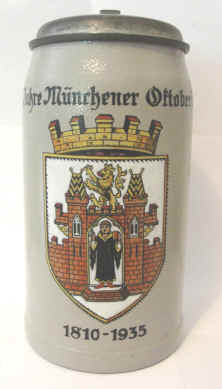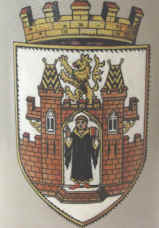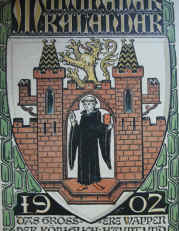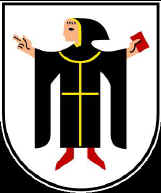 It’s Oktoberfest time again. What a great time of year for beer enthusiasts, those
looking to have a good time and those who enjoy a bit of history. Most of us are
aware that Oktoberfest (in Munich, that is) began as a wedding party in 1810 to
celebrate the marriage of Crown Prince Ludwig of Bavaria (later to become King Ludwig I)
and Princess Therese Charlotte Luise of Saxony-Hildburghausen. To this very day the
festival grounds carry the name of the royal bride; “Theresienwiese” or Therese’s meadow.
Last year marked the 200th anniversary of Munich’s Oktoberfest celebration and to
commemorate that event an official
"Jubiläumskrug" or anniversary stein was
created. This was not the first Oktoberfest anniversary stein that has been
manufactured. There are a number of other steins that some of you may be familiar with
but this article will focus on a lesser known 125th Oktoberfest anniversary stein.
It’s Oktoberfest time again. What a great time of year for beer enthusiasts, those
looking to have a good time and those who enjoy a bit of history. Most of us are
aware that Oktoberfest (in Munich, that is) began as a wedding party in 1810 to
celebrate the marriage of Crown Prince Ludwig of Bavaria (later to become King Ludwig I)
and Princess Therese Charlotte Luise of Saxony-Hildburghausen. To this very day the
festival grounds carry the name of the royal bride; “Theresienwiese” or Therese’s meadow.
Last year marked the 200th anniversary of Munich’s Oktoberfest celebration and to
commemorate that event an official
"Jubiläumskrug" or anniversary stein was
created. This was not the first Oktoberfest anniversary stein that has been
manufactured. There are a number of other steins that some of you may be familiar with
but this article will focus on a lesser known 125th Oktoberfest anniversary stein.
Our featured stein is a 1 liter salt-glazed stoneware stein accompanied by a plain pewter lid. The banner along the top reads, “125 Jahre Münchener Oktoberfest”. This is followed by a transfer and enameled design in the shape of a shield depicting a monk standing in the entryway of a gate wearing a black robe, trimmed in gold, and red shoes. His right hand is raised with fingers outstretched while his left hand holds a red book. Poised atop the gate is a lion and above the shield a crown. Below the graphics are the anniversary dates of 1810 –1935.
 My initial question was, “who designed this stein?” I thought I had the answer but
like so many initial conclusions a little more diligence never hurts.
Over the past
several years I’ve done a fair amount of research on the artist Otto Hupp
(take a look in the library section of the SCI website for more on Hupp).
Otto Hupp’s greatest passion was heraldry (coats of arms and crests).
One portion of his body of work includes the” Münchener Kalender”,
fifty-one calendars in all,
each profusely illustrated with Hupp’s heraldic images. When I compared the cover of
his 1902 calendar (at right) with the 1935 Oktoberfest stein I thought, that’s it,
this stein was designed by Otto Hupp. But upon reading the text on the cover of
the calendar I learned that this image is the large, or the great coat of arms
for the city of Munich dating back to 1330. King Ludwig I brought this historical
coat of arms back into use on 16 September 1834 after some time of absence.
His grandson, King Ludwig II made improvements on 11 June 1865.
My initial question was, “who designed this stein?” I thought I had the answer but
like so many initial conclusions a little more diligence never hurts.
Over the past
several years I’ve done a fair amount of research on the artist Otto Hupp
(take a look in the library section of the SCI website for more on Hupp).
Otto Hupp’s greatest passion was heraldry (coats of arms and crests).
One portion of his body of work includes the” Münchener Kalender”,
fifty-one calendars in all,
each profusely illustrated with Hupp’s heraldic images. When I compared the cover of
his 1902 calendar (at right) with the 1935 Oktoberfest stein I thought, that’s it,
this stein was designed by Otto Hupp. But upon reading the text on the cover of
the calendar I learned that this image is the large, or the great coat of arms
for the city of Munich dating back to 1330. King Ludwig I brought this historical
coat of arms back into use on 16 September 1834 after some time of absence.
His grandson, King Ludwig II made improvements on 11 June 1865.

Most of us are aware that the city of Munich, or München, derives its name from the word monk. It’s quite understandable that the central figure of the great coat of arms of Munich is therefore a monk. In his left hand he holds a book containing the laws of the city of Munich while his right hand is held up as if taking an oath. The lion above the city gate is the oldest symbol of the Wittelsbach family; the ruling family in Munich from 1240 to 1918. Is the gate depicted on this stein one of the original four city gates of Munich? There is some documentation to suggest it’s the Isartor but personally I see more similarity to Karlstor or the now extinct Schwabinger Tor.


Was there some foresight in using this historic great coat of arms on a 1935 stein? The question certainly needs to be asked for it was the very next year, 1936 that the Nazi Party revised the design by replacing the lion with the Reichsadler (above left). Not until 1949 did Munich return to their historic great coat of arms. The design continues to be used today although it was updated in 1957 by Eduard Ege. On 17 December 1957 the city council passed a resolution making the small version (above right) the officially used coat of arms while the large version would be used only for special occasions.
Who did the art work for this 1935 Oktoberfest anniversary stein? The answer remains a mystery and given that the original design dates from the late13th to the early 14th century I doubt we will every find out who the original designer was.